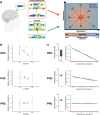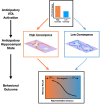Hippocampal convergence during anticipatory midbrain activation promotes subsequent memory formation
- PMID: 36344524
- PMCID: PMC9640528
- DOI: 10.1038/s41467-022-34459-3
Hippocampal convergence during anticipatory midbrain activation promotes subsequent memory formation
Abstract
The hippocampus has been a focus of memory research since H.M's surgery abolished his ability to form new memories, yet its mechanistic role in memory remains debated. Here, we identify a candidate memory mechanism: an anticipatory hippocampal "convergence state", observed while awaiting valuable information, and which predicts subsequent learning. During fMRI, participants viewed trivia questions eliciting high or low curiosity, followed seconds later by its answer. We reasoned that encoding success requires a confluence of conditions, so that hippocampal states more conducive to memory formation should converge in state space. To operationalize convergence of neural states, we quantified the typicality of multivoxel patterns in the medial temporal lobes during anticipation and encoding of trivia answers. We found that the typicality of anticipatory hippocampal patterns increased during high curiosity. Crucially, anticipatory hippocampal pattern typicality increased with dopaminergic midbrain activation and uniquely accounted for the association between midbrain activation and subsequent recall. We propose that hippocampal convergence states may complete a cascade from motivation and midbrain activation to memory enhancement, and may be a general predictor of memory formation.
© 2022. The Author(s).
Conflict of interest statement
The authors declare no competing interests.
Figures






Similar articles
-
Threat of punishment motivates memory encoding via amygdala, not midbrain, interactions with the medial temporal lobe.J Neurosci. 2012 Jun 27;32(26):8969-76. doi: 10.1523/JNEUROSCI.0094-12.2012. J Neurosci. 2012. PMID: 22745496 Free PMC article.
-
Reward modulation of hippocampal subfield activation during successful associative encoding and retrieval.J Cogn Neurosci. 2012 Jul;24(7):1532-47. doi: 10.1162/jocn_a_00237. Epub 2012 Apr 23. J Cogn Neurosci. 2012. PMID: 22524296 Free PMC article. Clinical Trial.
-
Repetition suppression in the medial temporal lobe and midbrain is altered by event overlap.Hippocampus. 2016 Nov;26(11):1464-1477. doi: 10.1002/hipo.22622. Epub 2016 Aug 12. Hippocampus. 2016. PMID: 27479864 Free PMC article.
-
FMRI signals associated with memory strength in the medial temporal lobes: a meta-analysis.Neuropsychologia. 2008 Dec;46(14):3185-96. doi: 10.1016/j.neuropsychologia.2008.08.025. Neuropsychologia. 2008. PMID: 18817791 Review.
-
Adult hippocampal neurogenesis for systems consolidation of memory.Behav Brain Res. 2019 Oct 17;372:112035. doi: 10.1016/j.bbr.2019.112035. Epub 2019 Jun 12. Behav Brain Res. 2019. PMID: 31201874 Review.
Cited by
-
Hippocampal Functions Modulate Transfer-Appropriate Cortical Representations Supporting Subsequent Memory.J Neurosci. 2024 Jan 3;44(1):e1135232023. doi: 10.1523/JNEUROSCI.1135-23.2023. J Neurosci. 2024. PMID: 38050089 Free PMC article.
-
High performers demonstrate greater neural synchrony than low performers across behavioral domains.Imaging Neurosci (Camb). 2024 Apr 15;2:imag-2-00128. doi: 10.1162/imag_a_00128. eCollection 2024. Imaging Neurosci (Camb). 2024. PMID: 40800471 Free PMC article.
-
Differential effects of expectancy on memory formation in young and older adults.Hum Brain Mapp. 2023 Sep;44(13):4667-4678. doi: 10.1002/hbm.26406. Epub 2023 Jun 27. Hum Brain Mapp. 2023. PMID: 37376724 Free PMC article.
-
Curiosity shapes spatial exploration and cognitive map formation in humans.Commun Psychol. 2024 Dec 30;2(1):129. doi: 10.1038/s44271-024-00174-6. Commun Psychol. 2024. PMID: 39738810 Free PMC article.
-
The magic, memory, and curiosity fMRI dataset of people viewing magic tricks.Sci Data. 2024 Oct 1;11(1):1063. doi: 10.1038/s41597-024-03675-5. Sci Data. 2024. PMID: 39353978 Free PMC article.
References
-
- Kentros CG, Agnihotri NT, Streater S, Hawkins RD, Kandel ER. Increased attention to spatial context increases both place field stability and spatial memory. Neuron. 2004;42:283–295. - PubMed
-
- Apitz T, Bunzeck N. Reward modulates the neural dynamics of early visual category processing. Neuroimage. 2012;63:1614–1622. - PubMed
Publication types
MeSH terms
LinkOut - more resources
Full Text Sources

